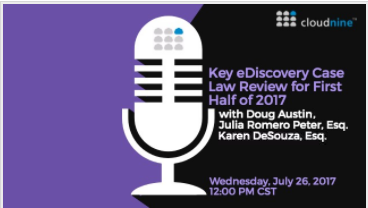Law Firms and the Billable Hour – The Debate Continues: eDiscovery Trends
Over four years ago, I asked the question of whether it’s time to ditch the per hour model for document review. Back then, I referenced an overbilling situation discussed in an article by a law firm that was recently in the news for a ransomware issue. But, the debate continues – should law firms still use the billable hour?
In Above the Law (Should Law Firms Still Use The Billable Hour?), in a conversation hosted by Zach Abramowitz (via his ReplyAll conversation mechanism), Zach facilitates a discussion between several legal experts regarding the billable hour and alternative fee agreements (AFAs). They include: Patrick Lamb, founder of the Valorem Law Group; Adam Steiner, software engineer turned practicing lawyer; Alma Asay, former Gibson Dunn litigator & founder of Allegory; Brad Blickstein, founder of Blickstein Group; Ken Grady, former GC, lean law evangelist at Seyfarth, and adjunct professor at Michigan State University College of Law; Catherine Krow, former partner at Orrick and founder of Digitory Legal; Mike Knowles, firm administrator at Emmanuel Sheppard & Condon; and Keith Lee, lawyer, blogger, and founder of Lawyer Slack.
So, should law firms still be using the billable hour in 2017? Here are some of the observations by the experts (and my comments in response):
Knowles: “One reason I feel the billable hour is such an ugly term is the surprise/shock the client experiences when they receive a bill. Having worked for 3 different firms, I think, most firms serve their clients well. But we do a lousy job of explaining the process and managing their expectations.”
Agreed – this is one of the biggest problems with the billable hour. Too many clients are getting “surprised” with the bill with no advanced expectation of what they should expect to pay for the services being provided.
Lee: “Litigation is often about creating variance. Relentlessly, exhaustively, exploring every Avenue and every possibility. Efficiency is not part of the menu because what matters is not being efficient, what matters is winning.
So we’re left with the billable hour.”
Well, that’s great, but winning at what cost? Is there an unlimited budget to “winning”?
Blickstein: “While there are some matters that are not predictable enough for AFAs (though I suspect if you chunk it up enough they probably are), I honestly think the single biggest reason that we are still using hourly bills is philosophical. Both lawyers and clients perceive the work as a function of time.”
Agreed, if the clients still perceive it that way, what motivation is there to change?
Asay: “When clients and law firms are on the same page about both expectations and curve balls, then whether fees are based on AFAs or billable hours or a mix of both, the relationship is ultimately a win-win.”
That’s ultimately the key. Staying on the same page with clients takes work and communication. Curve balls happen – there are always things that come up that you don’t expect – but, if you’re continuing to communicate with the client as those happen, you have a much better chance of keeping the client happy regardless of the billing arrangement.
These are just a sampling of the comments from the experts, click here to view the entire conversation.
So, what do you think? Should law firms still use the billable hour? Please share any comments you might have or if you’d like to know more about a particular topic.
Also, if you’re going to be in Houston this Thursday (July 20), Women in eDiscovery (WiE) Houston Chapter, in partnership with South Texas College of Law, will be hosting the inaugural eDiscovery “Legal Technology Showcase & Conference” at South Texas College of Law in downtown Houston. I will be participating as a panelist on the “State of the Industry” panel and my colleague, Karen, will be moderating the “Legal Operations and Litigation Support” panel. Click here for more information about the conference, including how to register!

Disclaimer: The views represented herein are exclusively the views of the author, and do not necessarily represent the views held by CloudNine. eDiscovery Daily is made available by CloudNine solely for educational purposes to provide general information about general eDiscovery principles and not to provide specific legal advice applicable to any particular circumstance. eDiscovery Daily should not be used as a substitute for competent legal advice from a lawyer you have retained and who has agreed to represent you.






